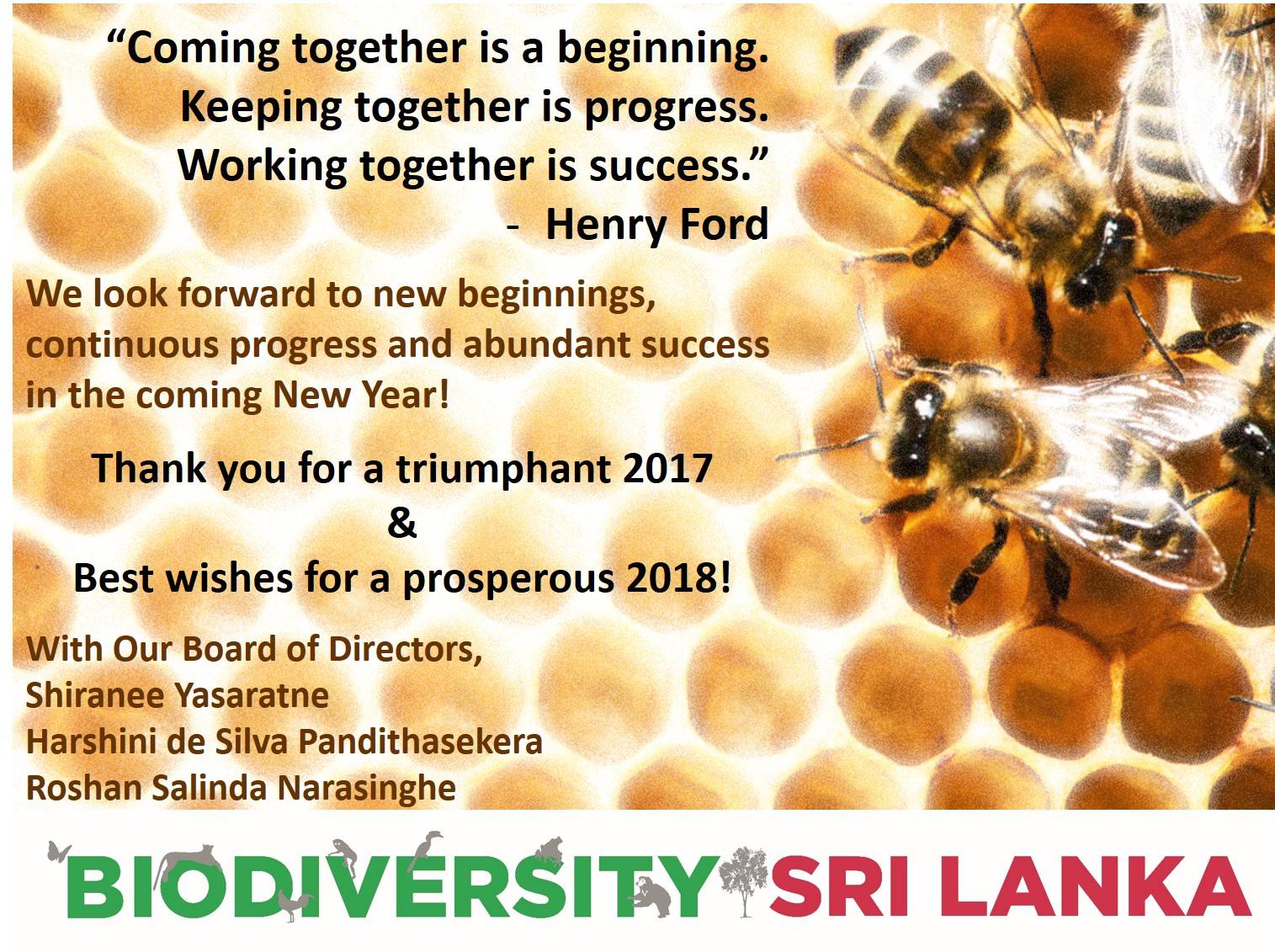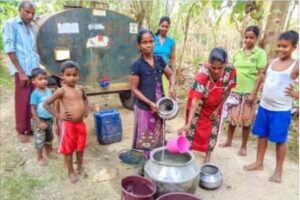
Ayurveda and Conservation Unite: Barberyn Ayurveda Resorts Becomes a BSL Member

We are thrilled to announce that Barberyn Ayurveda Resorts has joined Biodiversity Sri Lanka (BSL) as a new General Member. Nestled in the tranquil coastal town of Beruwala, Western Province, Sri Lanka, Barberyn Reef Ayurveda Resort Hospital is a sanctuary of holistic well-being and sustainable living. With a rich history spanning over 55 years, this pioneering Ayurvedic resort has seamlessly blended traditional healing practices with modern hospitality, creating a haven for those seeking rejuvenation and inner peace. Their membership in BSL is a testament to their unwavering commitment to environmental stewardship and sustainable development.
A Legacy of Holistic Healing and Sustainability
Founded in 1968 by visionaries Mr. Sudana Rodrigo and Mrs. Chitra Rodrigo, Barberyn Reef Ayurveda Resort Hospital has been at the forefront of Ayurvedic tourism in Sri Lanka. Their profound vision of sustainability, encompassing the sanctity of life, human consciousness, and inner peace, has guided the resort’s operations and growth. Today, under the leadership of their son, Manick Rodrigo, the resort continues to uphold these values, emphasizing human development that rests on the sustainability of life, both physical and spiritual.
Authentic Ayurvedic Healing
At the heart of Barberyn Reef Ayurveda Resort Hospital is its dedication to authentic Ayurvedic healing. The resort offers personalized treatment programs designed by experienced Ayurvedic doctors, including detoxification, rejuvenation, and stress relief therapies. Daily meditation and yoga sessions further enhance mental and physical well-being, while Ayurvedic cuisine, prepared according to Ayurvedic principles, focuses on nutrition and balance. Comprehensive wellness programs cater to various health needs, including weight management, skin care, and chronic illness management.

A Commitment to Sustainability
Barberyn Ayurveda Resort’s commitment to sustainability is evident in every aspect of its operations. The resort’s sustainability initiatives align seamlessly with the goals of Biodiversity Sri Lanka, making BSL membership a natural and harmonious partnership.
Reduce, Reuse, Recycle
The resort has implemented a robust waste management system, categorizing waste as degradable and non-degradable. Non-degradable waste is further sorted into plastic, iron, and glass, with plastic cans repurposed to grow plants in the nursery. Organic waste is recycled into compost and biogas, while non-degradable waste is sold for recycling. These efforts not only reduce waste but also promote a circular economy, aligning with BSL’s mission to promote sustainable resource management.
Go Green to Breathe Clean
With 80% of the land covered in greenery, predominantly herbal plants, Barberyn Reef Ayurveda Resort Hospital is a verdant oasis. The resort maintains a herbal plant nursery to supply medicinal plants for Ayurvedic treatments and propagation. This green coverage not only enhances the resort’s aesthetic appeal but also contributes to biodiversity conservation, a core focus of BSL.
Live Under Eco-Friendly Shelters
The resort’s buildings are designed with sustainability in mind, featuring natural ventilation to reduce the need for air conditioning and minimizing the use of plastics in construction. Most furniture is made from wood, further reducing the resort’s environmental footprint. These eco-friendly practices align with BSL’s goal of promoting sustainable building and construction practices.

Sustainability Through Renewable Energy
Barberyn Reef Ayurveda Resort Hospital has embraced renewable energy by installing solar panels for electricity generation. With a goal to meet the entire energy requirement through solar power by 2025, the resort is making significant strides towards reducing its carbon footprint. This commitment to renewable energy aligns with BSL’s mission to promote clean and sustainable energy solutions.
Path to Vegetarian – Take Extinction Off Your Plate
The resort has made efforts to minimize meat consumption due to its environmental impact, promoting a predominantly vegetarian diet. Innovative cooking methods are used to reduce edible food waste, further contributing to sustainability. These initiatives resonate with BSL’s focus on sustainable food systems and reducing the environmental impact of food production.
Sustainable Procurement
Barberyn Reef Ayurveda Resort Hospital sources eco-friendly products and materials, supporting local suppliers and producers to reduce the carbon footprint of hotel operations. This commitment to sustainable procurement aligns with BSL’s goal of promoting environmentally responsible business practices.
Clean Ocean for Healthy Joy
The resort conducts daily beach clean-up sessions to keep the shore free from plastics, contributing to marine conservation. This initiative aligns with BSL’s focus on protecting marine ecosystems and promoting clean oceans.
Environmental Education
Barberyn Reef Ayurveda Resort Hospital provides training and awareness programs for staff, guests, and the local community. Webinars, workshops, and seminars on sustainable tourism and the usage of indigenous medicine further promote environmental education. These efforts align with BSL’s mission to raise awareness and educate stakeholders on biodiversity conservation.

Environmental Conservation Projects
The resort is actively involved in mangrove conservation in the Didduwa area, tree planting initiatives, and maintaining medicinal plantations over 50 acres. These projects promote reforestation, combat climate change, and enhance biodiversity, aligning with BSL’s focus on habitat restoration and conservation.
Science for Every Single Bit of Nature
Barberyn Reef Ayurveda Resort Hospital has constructed wastewater treatment and biogas production plants using scientific approaches. Water used for consumption is tested every three months to ensure safety. These initiatives align with BSL’s mission to promote scientific research and innovation in environmental conservation.
Awards and Recognition
- Presidential Environmental Award 2024 – (Silver Award in Hotel Sector)
- Presidential Environmental Award 2023 – (Merit Award in Hotel sector)
- Presidential Environmental Award 2022 – (Merit Award in Hotel sector)
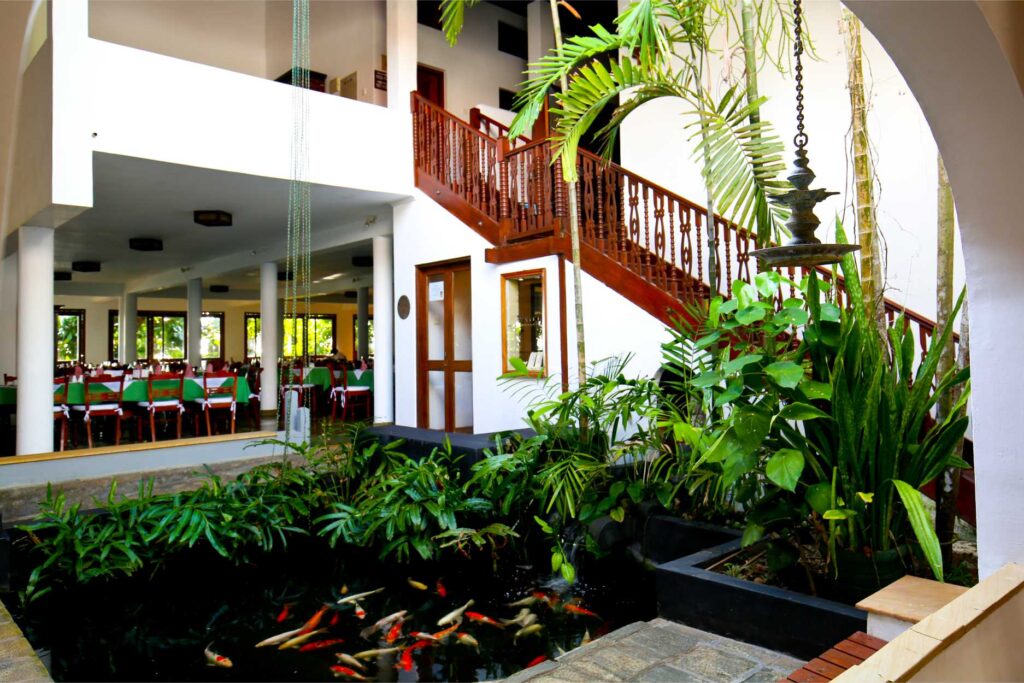
A Vision for the Future
As Barberyn Ayurveda Resorts joins Biodiversity Sri Lanka, it is a testament to their shared vision of a sustainable future. The resort’s holistic approach to well-being, combined with their commitment to environmental stewardship, makes them a valuable partner in BSL’s mission to conserve biodiversity and promote sustainable development.
Barberyn Ayurveda Resort’s membership in Biodiversity Sri Lanka is a natural alignment of values and goals. Their dedication to authentic Ayurvedic healing, sustainable practices, and environmental conservation makes them a beacon of sustainable wellness. As they continue to lead by example, Barberyn Ayurveda Resorts and Biodiversity Sri Lanka will work together to create a healthier, more sustainable future for all.
For further information, please visit the Barberyn Ayurveda Resort’s website: https://www.barberynresorts.com
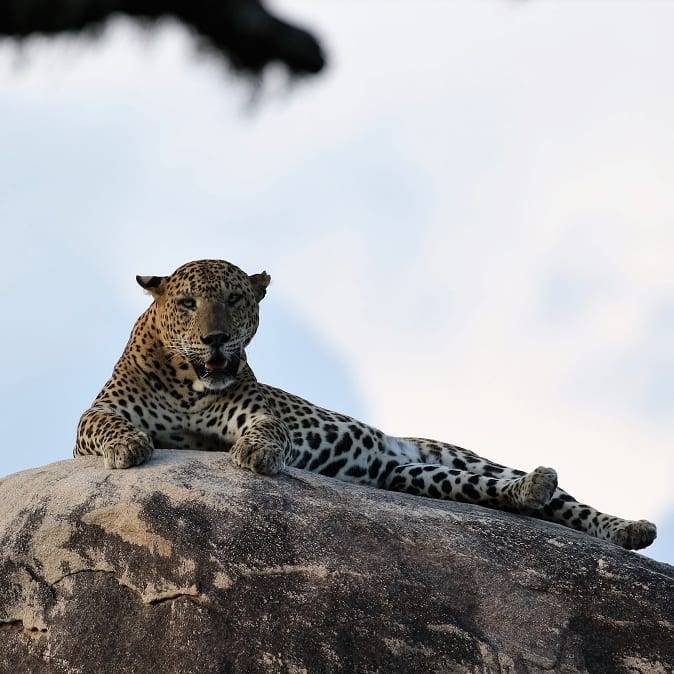
The Day of the Leopard
Picture credits: Chandika Jayaratne
The Sri Lankan Leopard (Panthera pardus kotiya) is a subspecies unique to the country, the apex predator on the island. As an indicator, umbrella and keystone species, the Leopard helps fulfill critical ecological roles in the ecosystem. The Leopard attracts visitors to our national parks and thus is an important revenue generator. The Leopard is listed in the threatened category in the National Red List (2012) due to the ongoing challenges the animal faces because of conflict with humans and loss of suitable habitat.
In 2021, the 1st of August of each year was declared as Sri Lanka Leopard Day by the Department of Wildlife Conservation, in collaboration with the Wildlife and Nature Protection Society (WNPS), as it helps celebrate this iconic animal whilst continuing to help raise awareness on the continuing threats faced by the species.
Picture credits: Chandika Jayaratne
The leopard, Sri Lanka’s apex carnivore, plays extremely important roles in both the ecology of the island and the long-term conservation of Sri Lanka’s biodiversity. “Sitting at the top of the food chain, there is a strong possibility that the leopard is a “keystone” species in Sri Lanka – meaning that its presence within ecosystems here is far more valuable to the effective functioning of those systems than its relatively modest population numbers would suggest. Remove it from those systems and they may teeter and crash, or at least become less productive,” said Dr. Andrew Kittle and Anjali Watson, Founding Trustees at the Wilderness and Wildlife Conservation Trust (WWCT).
Picture credits: Chandika Jayaratne
They further said that its role in the conservation of biodiversity stems from being both a “flagship” and “umbrella” species. “As a breathtakingly beautiful, charismatic large carnivore, the leopard is widely admired and can act as a “flagship” which can rally conservation efforts – and garner often elusive conservation support – which can benefit not just the leopard but a wider array of species. Due to the fact that leopards are extremely adaptable, living in all habitat types in Sri Lanka, and are also wide-ranging and territorial (a factor that ensures even more space is required for a viable population), they are very useful “umbrella” species. This means that ensuring the long-term protection of a robust leopard population in Sri Lanka ensures, by default, the conservation of a host of smaller and more spatially restricted species that fall under its ‘ecological umbrella’.
“WWCT utilizes these aspects to focus on landscape-level conservation of the leopard and wider biodiversity, by identifying leopard refugia and movement corridors which link larger forested and/or protected areas in the Central Highlands as well as in other parts of the leopard’s island-wide range. Once identified, these vital links become the focus of collaborative conservation efforts to ensure their continued use.
“Sri Lanka benefits from the presence of the leopard on its forest trails and mountain slopes – ecologically through its role in the system, economically through the revenue that it garners as a star attraction in National Parks, and aesthetically, marked by the quickening of the pulse and sharp intake of breath that so often characterizes a glimpse of this graceful, elusive predator,” they added.

With the CBD COP 15 approaching, Biodiversity Sri Lanka examines what nature-positive means for business?
In December 2022 the world has a unique chance to renew its relationship with nature by adopting a new and ambitious post-2020 Global Biodiversity Framework (GBF) during the 15th conference of the parties to the Convention on Biological Diversity.
Nature underpins prosperity and well-being through the services provided to society and the economy. People rely on nature for services without which their lives would not be possible, such as clean air and water, fertile soil for food, and pest and disease regulation. The interactions between the different elements of nature provide “services” or contributions to society and the economy worth USD $43 trillion. More than half the world’s GDP depends heavily on the functioning of these natural ecosystems. What does nature-positive mean for business?
These “building blocks” guide businesses to act now to halt and reverse nature loss, and credibly contribute to a nature-positive world, with positive impacts outweighing negative impacts on nature from 2030 onwards.
FOR SUPPORT IN THE APPLICATION OF THESE ”BUILDING BLOCKS” – PLEASE CONTACT US
- Assess and Prioritize
Assess realms of nature (biodiversity, freshwater, land, oceans) potentially relevant to operations and the value chain, and prioritize impacts, dependencies and opportunities for regeneration.
Businesses should consider both the living (i.e., biodiversity) and non-living elements that are potentially relevant within all realms of nature (land, freshwater and oceans). Then prioritize them based on an assessment of the material impacts and dependencies on biodiversity and ecosystem services within their direct operations and value chains, and the related risks and opportunities for business, people and the natural world.
- Commit
Set a baseline and commit to ambitious, time-bound, science-informed goals and targets to both halt and reverse the loss of nature.
Building on existing commitments and actions related to nature, businesses should aim to both:
- Halt – Minimize their contributions to negative outcomes for nature and reduce pressure on nature;
- Reverse – Maximize their contributions to positive outcomes in terms of health, abundance, diversity and resilience of species, populations and ecosystems
- Measure & Value
Use validated, interrelated indicators to measure nature outcomes that inform decision-making.
Businesses typically start by measuring and reporting on their business response or actions and resulting change in applicable pressures on nature: land or sea-use change, direct exploitation, climate change, pollution, and invasive species. Businesses can use a framework of indicators to gain a holistic picture of progress on nature goals and targets in order to inform decision-making within and outside businesses
- Act
Businesses should embed nature considerations and aim for nature-positive outcomes across all their spheres of control and influence, prioritizing where there is greatest impact and leverage
Systematically apply the mitigation hierarchy within and beyond corporate operations to reduce pressures and have positive contributions across your value chain.
Halt: Businesses should give priority to avoiding and reducing pressures on nature across all scales of action, particularly for critical ecosystems
Reverse: Businesses should also put in place complementary actions to protect, restore and regenerate nature, including in their wider spheres of influence, including site-based practices as well as product and business-model design.
- Transform
Collaborate to achieve nature-positive outcomes across all spheres of control and influence, including policy, financing and capacity building.
While the potential negative and positive impacts and opportunities will vary across value chains, net-positive is the aspirational direction for all businesses. To help scale up actions and contribute to true systems transformation, businesses should aim to catalyze lasting change and proactively collaborate with key stakeholders at all system levels
- Disclose & Report
Prepare to disclose material nature-related information
Following in the footsteps of climate, businesses should be aware of the growing momentum for nature-related disclosures to help shift finance away from nature-negative outcomes and toward nature-positive outcomes. Business responses to manage those risks and opportunities, including relevant governance structures, strategies, and targets, that will inform investment decisions in the financial system and real economy Thus, disclosure and reporting support the implementation of the other building blocks.
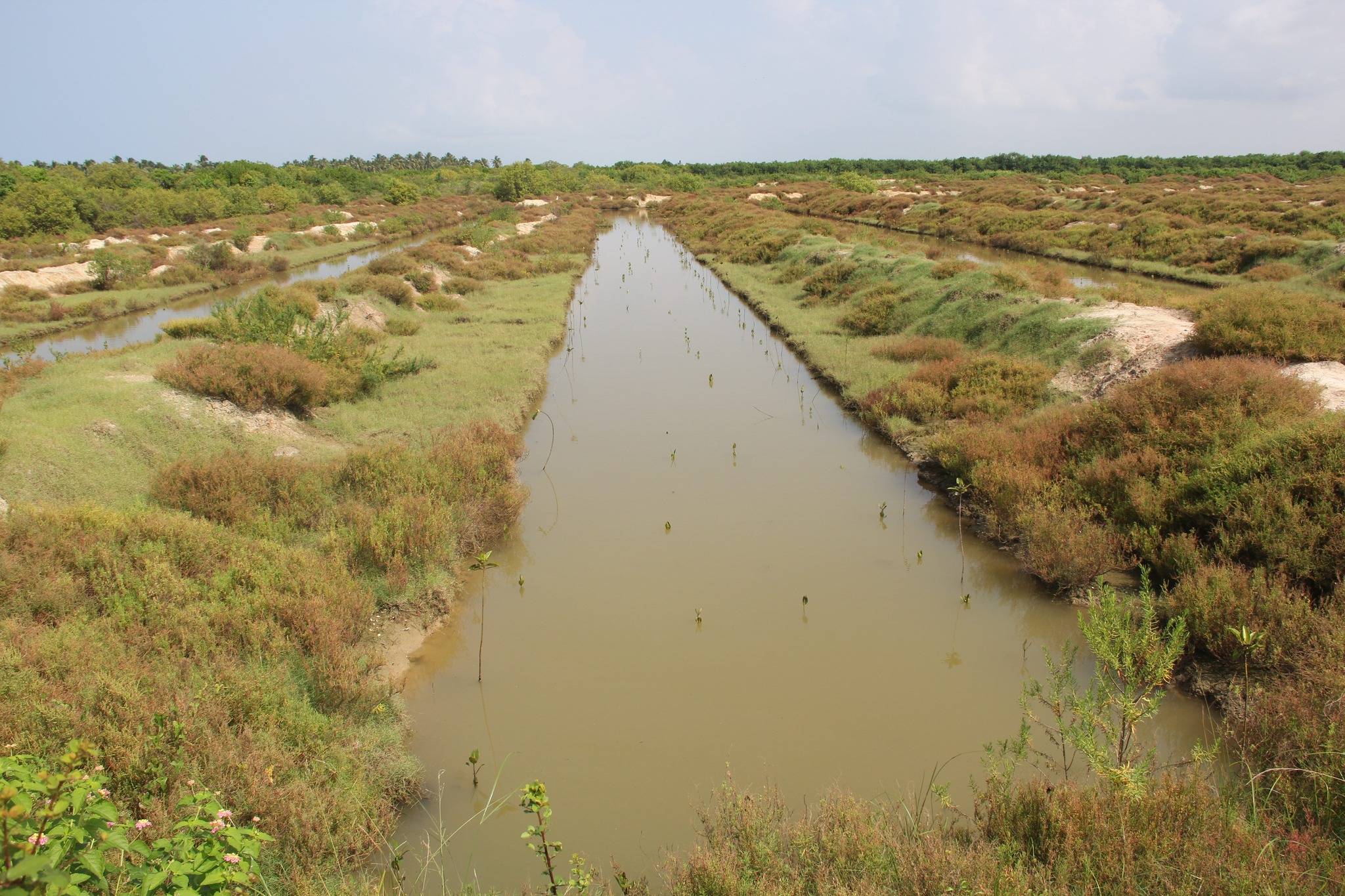
Soil Organic Carbon Stocks in Wetlands maintain a steady Carbon Cycle – In Celebration of World Wetlands Day
On 2nd of February 2022, as it does each year, the world celebrated World Wetlands Day. The pre-declared theme for this year was “Wetlands Action for People and Nature” which has been set to draw attention on the sustainable use of wetlands and for promoting wetland conservation efforts. A wetland is an area of land that is either covered by water or saturated with water either permanently or seasonally. Marshes, swamps, bogs, and fens are the four main types of wetlands.
Wetlands are highly productive ecosystems which offer various ecosystem services such as increased water quality, flood regulation, nutrient recycling, pollution control, providing habitat and breeding grounds for fauna and flora species including migratory water birds and for providing recreational, economic and cultural services to people.
The extent of the world’s wetlands is estimated to be about 5–8% of the total land surface on earth. Despite this low representation as a percentage of area on land, wetlands among all terrestrial ecosystems have the best capacity to sequester and retain carbon through long term burial. Soils have a significant capacity to sequester carbon. Out of the total storage of carbon in earth’s soils 20-30% are stored in wetlands (Lal 2008). Carbon sequestration rates of coastal wetlands and freshwater wetlands are higher than terrestrial forests. Waterlogging soils limit oxygen transmission and creates an anaerobic condition. This condition slows down the decomposition rate of organic matter, leading to build up and storage of large amounts of organic carbon in wetland sediments. The hydrological connection between waterways and their associated floodplains plays an important role in terms of exchange of carbon and nutrients (i.e., wetlands can trap carbon rich sediments from catchments, but may also disperse carbon through water flow into floodplains[1])
Wetlands play an important role in regulating exchanges of greenhouse gases (GHGs). They play both roles as sink (process that absorbs) and source (process that releases) in term of absorbing and emitting GHGs. The anaerobic conditions are conducive to the production of greenhouse gases such as methane (CH4). When wetlands are flooded and anaerobic conditions exist, methane is produced. When these wetlands are dry, they act as methane sinks. Comparatively, coastal wetlands emit lower methane than freshwater wetlands because salinity inhibits the production of methane.
Wetlands have a significant potential in addressing climate change mitigation due to their high capacity to sequester carbon dioxide (CO2). Peatlands which are a type of wetland are recognized as the largest natural terrestrial carbon sink. Worldwide, the remaining area of near natural peatland sequesters 0.37 gigatonnes of CO2 per annum (IUCN, 2021). The same source indicates that peat soils contain more than 600 gigatonnes of carbon which represents up to 44% of all soil carbon, and exceeds the carbon stored in all other vegetation types including the world’s forests. Wetlands could also become net carbon sources due to natural processes and anthropogenic activities. Degraded peatlands act as major sources of GHG emissions, releasing roughly 5% of all global anthropogenic greenhouse gas emissions per annum. In fact, land use changes cause abrupt, significant changes in wetland soils which could potentially convert long-term carbon sinks into sources of carbon in the atmosphere.
The impacts of climate change on wetlands are complex. As indicated through a study in Australia, warmer climates will accelerate the rate of production of carbon dioxide and methane from wetland soils, wetter climates will increase wetland surface areas and promote carbon sequestration and increased primary production, but may increase methane emissions. Drier climates will increase the oxidation of carbon stores but reduce methane emissions.
The Ramsar Convention recognizes the importance of the conservation and sustainable use of wetlands. Reduction of land-based emissions via conservation of existing wetland ecosystems and the increase in the rate of carbon sequestration by wetland ecosystems will reduce net GHG emissions that would lessen the pressure on natural and human systems from climate change. Therefore, managing soil organic carbon stocks in wetlands should be given a high priority in order to maintain a steady carbon cycle and thereby address climate change mitigation aspects.
[1] https://www.awe.gov.au/sites/default/files/documents/wetlands-role-carbon-cycle.pdf, Accessed on Feb 25, 2022
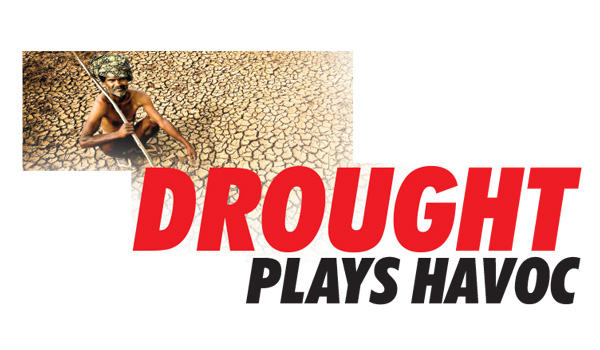
Drought plays havoc
.jpg)
All nine provinces in the country are suffering from a severe drought due to insufficient rainfall. The government requests the residents in these areas to use water with much care and minimize wastage, especially due to the despite the little rainfall received in the past few weeks. The country’s drinking water crisis continues as storage levels of many tanks have dropped drastically. What is worse is that according to the Meteorological Department there will be no rain in these areas until October.
The latest data on electricity generation for 2016 and up to March 2017 released by the Public Utilities Commission of Sri Lanka (PUCSL) shows the sharp impact of the drought on hydro electricity generation. By Q4 2016 and Q1 2017 reservoir levels were at their lowest in five years, and this has had a major impact on the cost of electricity generation as the CEB had to switch to thermal generation. At a higher cost. CEB hydropower generation in Q1 of this year (2017) was the lowest compared to Q1 of the past three years.
Since June/July, 2016 through to March 2017, electricity generation in all hydropower stations was halved (or more) due to the drought. On average every month, the top 6 largest hydropower plants were operating at a fraction of their full capacity.
Irrigation
Irrigation mainly for agriculture purpose has been highly affected by the drought and many agriculture farmers are finding it difficult to maintain their cultivations. Due to low production, vegetable prices have been rising over the time. According to Wasantha Bandara Palugaswewa, Director Irrigation, Water Management, and Training, Department of Irrigation, out of major tanks 73 have got only 15 per cent of overall capacity.
“We have completely cut down the water supply to paddy fields in drought affected areas at the moment,” Palugaswewa said. “We carefully manage water with the help of Sri Lanka Police and I hope we can save the crops,” he added.
Cultivations and farms
The prevailing dry weather conditions are severely damaging the crop production as well as the livestock industry in the country. The drought that lasted for nearly eight months has turned into a crisis situation for many cultivators as well as the farmers in affected areas.
For most of the farmers, it is the worst condition they have seen in decades. Survival has become their only goal as there is no sign of rain for months. Namal Karunarathne, National Organizer, All Ceylon Peasants’ Federation said, ” 118 District Secretariats have been affected by the drought. Areas like Vilachchiya in the North Central Province, which I have visited personally many cultivators are suffering without water even for their consumption like drinking, washing, and cooking. The situation in Ampara remains the same.
“Sri Lanka has enough rivers but we don’t utilize these rivers in a proper manner,” he added. “Many major rivers have been blocked to generate electricity, but what I suggest is generating electricity has many options but agriculture does not. So we should utilize our river water mainly for agriculture and find out alternatives to generate electricity,” Karunarathne said.
Dairy farmers
Not only cultivators but also dairy farmers have equally been affected, he further stated. Especially in areas like Trincomalee, Seruvila and Vilachchiya cattle do not have enough water to drink and some farmers have started selling their herd for meat since they do not have a way of providing food and water. “Dry weather has eliminated many grazing areas and also the government has restricted cattle from entering forest reserves which I think is not fair,” he said. These innocent dairy farmers and their cattle do not harm the forest. I think the government should call an emergency situation for this drought and seek international assistance and aid to stop people suffering.
However, a senior official from a leading dairy company, one of the country’s leading milk-based product manufacturer said they have not seen any decline in their milk supply. “Some of the small scale private milk collectors have stopped purchasing milk from dairy farmers and I do not know whether that is the reason for our supply to remain the same even in areas like Batticaloa, Anuradhapura and Ampara which are severely affected by the drought,” he added. “I think nowadays most of the dairy farmers do not send their cows to the jungle for grazing, but they provide food and water by themselves. So these cattle are not affected by the drought, he further stated.
Disaster management measures
We see a drastic change in the world’s climate and many forest covers having been cut down for various development purposes which lead to the long lasting droughts as well as the drop in ground water levels. According to the National Disaster Management Centre (NDMC) data, more than one million people are suffering for nearly eight months in all the nine provinces in the country due to the ongoing dry weather. The government has already sanctioned more than Rs 40 million to District Secretaries mainly to address the drinking water issue. More than 6,000 tanks have been allocated in many different locations to provide clean drinking water to the affected communities.
Pradeep Kodippili, Assistant Director, NDMC said still some of the areas are not getting sufficient amount of drinking water. Within the 2-3 months we have provided 200 water bowsers and we have been providing them for some time, he added. The Northern Province is the worst affected and even most of the areas in the Eastern Province have not received rain.
Answering a question on whether there were any funds distributed among the affected residents he said funds had been distributed to farmers for their damaged crops for the eight months of drought. The Ministry of Disaster Management has established Disaster Management Units to coordinate ground level conditions. The drought has affected the whole economic situation in these areas Kodippili added. “I should say that the areas like Kalutara and Moneragala which were also affected by the drought have come out of danger as these areas have started experiencing sufficient rainfalls.
“And we are continuing our funding to provide drinking water to drought affected areas,” he said. We have enough funds allocated. We have provided a 24-hour service to the residents so that they can call us if they are in need of drinking water.
Drought mitigation projects
As a long-term measure the NDMC carries out drought mitigation projects which include rainwater harvesting projects and constructing irrigation wells. “We hope to expand our drought mitigation measures with more funds in the future,” Kodippili said. “The government is working on a project with the Arthur C. Clarke Centre for monitoring droughts and predicting them in the future.” he added.
Kodippili also said, “The people need to save water especially and they should properly utilize rain water. There should be a proper mechanism to protect the existing water bodies without getting contaminated.
The country also needs new policies or revise the existing ones in order to face disasters such as droughts.”
Global climate is changing rapidly resulting in many natural disasters in various parts of the world.
As a country with a proud history of being the number one rice producer in the region Sri Lankans had the best practice of using tanks and other water bodies. Both traditional knowledge and discipline were around the use of water.
Many of these practices have disappeared over time. Traditional crop patterns have not been followed by many farmers while encroachments and dumping of waste have increased rapidly. Rapid development has led to the clearance of many natural forest covers.
As a result, we are dealing with more natural disasters such as floods, droughts, cyclones and even landslides causing many deaths and damage to residents. Drought conditions are getting worse day by day in several provinces, and the extremely hot weather has led to stress in daily life and damage to crops and livestock. Preparedness, awareness and proper management of forests and water bodies can only minimize the effects of these harsh weather conditions and no government can alone work towards them.
source – ceylon today, See more at – http://www.ceylontoday.lk/print20170401CT20170630.php?id=27087

Projects to check growing garbage crisis
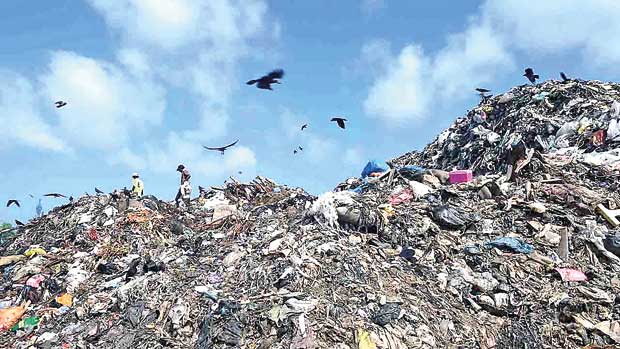
Garbage is not a problem only in Sri Lanka, but also in the rest of the countries. What is vital in this case is not how muck is collected in countries, but how the collected garbage is properly managed and recycled. It is evident how the garbage issue has affected our people and the country owing to the lack of management mechanism to utilize garbage.
I don’t want to reiterate the tragedy and the trouble caused to the people. It is pointless to claim how much garbage is collected. The governing body and its institutions should address the issue positively and take prompt actions to manage and recycle garbage.
It is in fact heartening to say that the Western Provincial Waste Management Authority (WPWMA) has been vocal on this issue and has launched two major projects to recycle garbage and generate electricity. In a discussion with Daily Mirror, the Director of the Western Provincial Waste Management Authority Nalin Mannapperuma said that there has been a drastic change during the past few decades in the physical environment in the country especially in the Western Province. He highlighted that one of the main reasons for this transformation is garbage.
“The main factors that relate to garbage generation are the population and the economic status. It has been analyzed that the economic status of the people living in the Asian and the Asia-Pacific regions will enhance in few decades; consequently there will be a boost in the resource consumption. Hence, there is a tendency for the considerable inclination in the garbage generation in a few decades. It has been estimated that in lower /lower middle income countries (which includes many Asian Countries) waste generation rates will more than double over the next 20 years. We as an Asian country have to face this situation. We can’t avoid it. The Municipal Solid Waste (MSW) in Sri Lanka has been estimated at 7000 Metric ton per day. The contribution from the Western Province to the Municipal Solid Waste (MSW) is 60% (3500 Metric tons per day). The annual growth rate of garbage generation in Sri Lanka is regarded as around 1.2-2.0%,” the Director said.

“The main factors that relate to garbage generation are the population and the economic status”
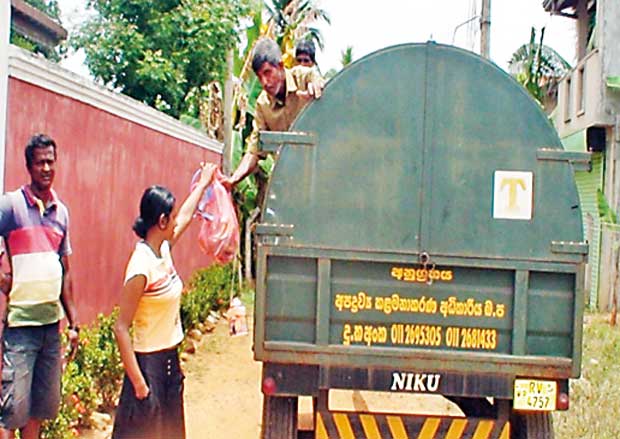
The fact is coherent that Sri Lanka is experiencing a massive garbage crisis and therefore productive actions need to be taken before the condition worsens. Moreover, it is identified that there are 25 dumpsites in the Western Province which are piled up with various types of dirt without a solution for the recycling process. At the same time, it is pleased to know the mapping of a master plan known as the Municipal Solid Waste (MSW) management which will be set to embark in 2018. Until it will be put it to practise, there are ongoing waste management practices as follows.
-
Reduction of garbage generation
-
Source segregation
-
Reusing
-
Recycling
-
Collection
-
Transportation
-
Small /Medium Scale Composting (140 IN SL, 25 in WP)
-
Small/ Medium Scale Bio gas production (no of units 150,000 unit in SL)
-
Small/medium scale Recycling centres
-
Turnkey basis
-
Public Privet Partnership basis
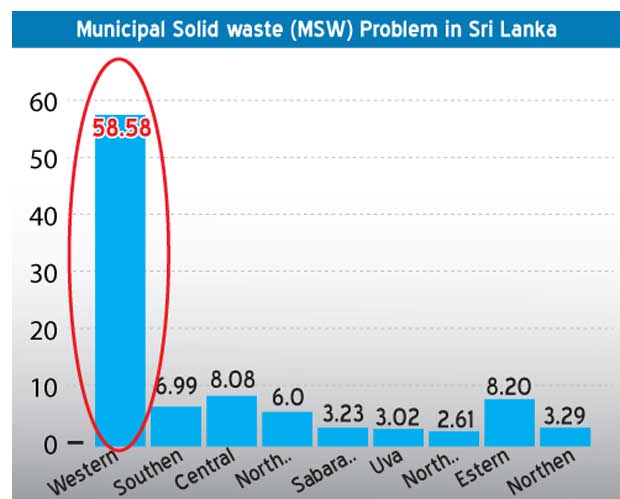
When considering the above actions, we can see that the Western Provincial Waste Management Authority (WPWMA) as a supporting agency to the Local Authority has done a sensible job in monitoring effective methodologies to find solutions to the garbage crisis.
“We have tried on several occasions to find solutions for the garbage issue. But our attempts were unsuccessful due to public protests and the high capital cost. Then we have to seek private and public aid. Therefore, we have endorsed two agreements with Fairway Waste Management (pvt) Ltd which will merge with Germany and Denmark companies and Trilogy ETC (pvt) Ltd. which will merge with OPUS Clean Energy Alliance.” The Director said.
He said that the fist company will commence the project with the garbage capacity of 500mt per day in Karadiyana which would generate 11.5 megawatt (MW) and this will release 89mn kilowatt to the grid per year. As a result of that, it will be adequate to generate electricity for 35000 families. Apart from the generation of electricity, the project is also equipped to generate 41000 tons of liquid fertilizer and 75000 tons of solid fertilizer. The total investment on this project is 73 USD. Then the second company will commence the project with the garbage capacity of 95mt per day at Gampaha, Dambuwatta which would generate 3.4 megawatt (MW). The technology which is to be used for this project is gasification i.e. burning the garbage. The total investment on this project is 30 USD.
In conclusion, the Director of WPWMA expressed his thanks on behalf of the authority to Isura Devapriya, the Chief Minister of the Western Province for the instructions given and the support rendered towards the upcoming project proposals and the issue of garbage. Nevertheless, the Director requests the general public to cooperate with local authorities in segregating and disposing their garbage at appropriate places, so that the muck collectors could collect them conveniently.
Source – Daily Mirror, See more at – http://www.dailymirror.lk/article/Projects-to-check-growing-garbage-crisis-132112.html

Drinking water for drought affected K’gala District
Drinking water is being distributed to 70, 454 drought affected families in 492 Grama Niladari Divisions in 24 Divisional Secretariat Divisions in Kurunegala District, said District Secretary Gamini Illangaratna.
A total of 204, 760 families belonging to 1,610 Grama Niladari Divisions are receiving drought relief. Under this scheme, a family of two receives dry rations worth of Rs 2,000 for two weeks while a family of three or more receive Rs 2,500 worth of dry rations for two weeks which is distributed by cooperatives.
Source – 30/08/2017, Ceylon Today See more at – http://www.ceylontoday.lk/article20170401CT20170930.php?id=6200

Sri Lanka Going Green

Within our children’s lifetimes, Sri Lanka will be powered entirely by green, renewable energy. This optimistic prediction appeared in a new report produced jointly by the United Nations Development Programme (UNDP) and the Asian Development Bank (ADB). It also says that electricity production will increase almost ten-fold from the current 3,700 megawatts to about 34,000 megawatts.
The report titled ‘Assessment of Sri Lanka’s Power Sector—100 per cent Electricity Generation through Renewable Energy by 2050,’ says that 15,000 megawatts will be wind energy and about 16,000 megawatts will be solar energy.
The rest of the power is expected to come from hydro and biomass based plants. They will help to balance supply – to deal with the peaks and troughs in renewable generation which occur when the sun goes in and the wind drops.
There will also need to be electricity storage solutions to provide instantaneous power of 3,600 megawatts and an energy storage capacity of 15,000 megawatt hours. This is needed to ensure stability of the electricity grid and make sure the lights always stay on.
But what would these storage solutions look like? Excess power produced by solar and wind could be converted by electrolysis into hydrogen gas, which could be burnt at night to produce electricity. This is a completely clean technology that produces pure water as a by-product.
Giant batteries
Another storage method would be giant batteries. In July, it was announced that Elon Musk, the billionaire founder of Tesla, will build the world’s largest lithium ion battery to store renewable energy in South Australia in partnership with French energy utility Neoen.
The 129 megawatt hour battery, which is paired with a wind farm, is designed to improve the security of electricity supplies across South Australia.
Musk told reporters in Adelaide the project was not without technical challenges, given it would be the largest battery installation in the world “by a significant margin.”
“When you make something three times as big, does it still work as well? We think it will, but there is some risk in that,” he said.
“We’re confident in our techniques and the design of the system.”
The battery forms a key part of the state government’s $550m energy plan drawn up after last year’s state-wide power blackout – and if it is as successful as Elon Musk hopes, could form the basis of energy storage solutions in Sri Lanka in the future.
The UNDP and ADB report also has good news for the Sri Lankan economy. It suggests that the country could save a total of $18 billion between now and 2050 as the island moves away from imported oil and coal to clean, home grown renewables.
The report estimates that in order to transition to 100% electricity generation by renewable energy, Sri Lanka will need investment of $50 billion. This sounds like an enormous amount of money, but spread over the next 30 years it works out at less than $2 billion a year.
According to the Director of the South Asia Energy Division, Priyantha Wijayatunga, “The ADB has expressed its continuous support for low-carbon development of Sri Lanka.” “Recent proposals including a rooftop solar programme and a large-scale wind power project demonstrate the ADB’s commitment in this regard. This assessment report can serve as a comprehensive example for future utilities globally on how decentralized clean energy services can be governed.”
Way forward
Climate Change Technical Adviser of the UNDP, Alexandra Soezer agrees that green energy is the way forward for Sri Lanka. “We will continue to expand our activities in this field and pave the way for a better tomorrow.”
It’s not only in Sri Lanka where renewables are making huge progress. For example, Norway is becoming the world’s first fully electric-powered country with a concerted push for sustainability, according to an energy think tank.
EnergiNorge, an industry advisory body, set out its green energy programme and said it was possible for the country to operate entirely using clean electricity by 2050.
Hydropower is currently the source of over 96 per cent of Norway’s electricity and there are more than 110,000 electric cars in use in the country and the government recently declared that no vehicles powered by fossil fuels will be sold in Norway after 2025.
According to the Director of EnergiNorge, “Our target is for Norway, based on hydropower and better collaboration between businesses and the authorities, to become the world’s first fully electric society by 2050. That will enable us to take a leading role in climate work while improving our competitiveness.”
Meanwhile, in India the price of solar energy has fallen so quickly this year, that it has cancelled plans to build nearly 14 gigawatts of coal-fired power stations. Analyst Tim Buckley said the shift away from the dirtiest fossil fuel and towards solar in India would have ‘profound’ implications on global energy markets.
This is already being reflected, with solar panel capacity set to overtake nuclear energy next year in a historic landmark.
The total capacity of nuclear power is currently about 391.5 gigawatts, but the total capacity of photovoltaic cells is expected to hit 390 gigawatts by the end of this year with demand growing at up to 8 per cent per year, according to GTM Research.
While this would be a landmark moment for renewable energy, nuclear still generates much more electricity than solar – nearly 2.5 million gigawatt-hours a year compared to the latter’s 375,000 gigawatt-hours.
Stephen Lacy, writing on GTM’s website, said: “It’s still going to be a record-breaking year for new solar capacity additions – yet again.”
Stephen Lacy added: “In the last three years, growth rates and cost reductions for solar have far exceeded projections. Meanwhile, high costs, slow construction, and competitive renewable alternatives are causing the global nuclear industry to falter.”
“The trend lines are becoming clearer every year.”
The sun delivers enough energy to the earth in an hour to provide humans with everything they need for an entire year.
As a tropical island, Sri Lanka is well placed to take advantage of all this free energy – as long as the country can continue to develop green energy policies and attract the necessary foreign investment.
Source – 30/08/2017,Ceylon Today, See more at – http://www.ceylontoday.lk/print20170401CT20170630.php?id=28826
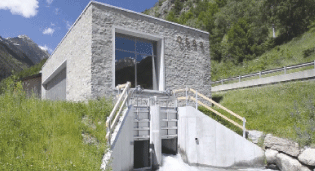
Sinharaja in Danger
Alleged illegal construction of mini hydro power plants projects in the Sinharaja Forest Reserve, a national park and a biodiversity hotspot in Sri Lanka, has caused many environmental damages to the world heritage. Sinharaja is of international significance and has been designated a Biosphere Reserve and World Heritage Site by UNESCO.
The illegal construction of the Project that crosses the Kosgulana River and along the water catchment areas of Diya Eli, Ganga Jala in the Sinharaja Forest buffer zone has caused considerable damages to the rainforest, even though the environmentalists and the Rainforest Protectors Organization raised concern over the environmental damages resulted by the project. In the meantime, the relevant authorities are being informed about the damages caused by the project, and they are accused of being silent over the law violation.
The Ministry of Power and Energy has planned to construct108 Mini Hydro Power Plants in one of the high bio-diversities of the country along Sripada, Sapthaya Kanya, Maskeliya Oya, and through Lakshapana Dam and V-Oya without any proper Environmental Impact Assessment (EIA) being conducted by the relevant authorities, while causing damages to the environment, and the water sources of the country. This construction is being carried out in the Northern Sinharaja Rainforest buffer zone at Kosgulana, approximately 4km East from Kudawa main entrance.
Ampanagala, Vevathenna, Kombarava Ganga, Dambulu Oya, Banamadu Oya, Gombarau Oya, and many lakes and water streams are being affected and damaged by this project. “The construction of this project on the basis of economic development is being carried out while ignoring the protection of nature reservoirs and the water sources of the country,” claimed Ravindra Kariyawasam, the environmentalist and Director for Center for Environmental and Nature Studies (CENS).
More than 78 Private companies will be benefited from this project of 108 mini hydro power plants to which many environmental committees have expressed concern over the environmental damages caused by it. Nevertheless, the project is under construction and reported as a violation of the National Environmental Act of Sri Lanka.
He also claimed that the project carries out the blasting method in its process which has caused visible damages to the rainforest and the gravel roads of Sinharaja Rainforest. “Many environmental damages are allegedly being posed to while the groundwater level of the areas is going down,” he said. Moreover, the wild animals and birds that depend on the water catchment areas of the rainforest are also being exposed to these environmental damages. He also alleged the Central Environmental Authority (CEA) for not attending to their duties of protecting the bio-diversities and the nature reservoirs of the country. Fences were being built to block the pristine water streams from entering into the constructional areas while obstructing the speed of water flow which will result in the reduction of oxygen in the water. Due to this temperature of water changes causing discomfort for the animals and the water creatures in the rainforest.
Moreover, a dam is being built blocking the Kosgulana River in the Sinharaja buffer zone and several acres of rainforest cleared by heavy machinery and concrete along the pristine and protected river bank. Large trucks and machinery utilized for this construction had cleared through what was once a small footpath in the Sinharaja buffer zone, between Kudawa and Kosgulana.
“As a result of the rainforest continuously being exposed to deforestation and anti-environmental friendly projects within the conservative areas, the level of rain that the country receives every year has been reduced which will also result in affecting the people and the wildlife of hill countries,” said Ravindra Kariyawasam.
A research conducted by the International Energy Agency (IEA), a Paris-based organization established in 1974, reveals that the groundwater level of the area and the environment is exposed to an irreparable damage when such anti-environmental projects are carried out in the conservative areas. For Example, the Azwam mini hydropower plants project in Egypt reportedly affected the villagers and the wildlife in the area.
“The result of Randenigala and Victoria projects that claimed to produce power even to India is a good example to stop these anti-environmental projects in the country as those projects were a failure in protecting the environment,” said Ravindra Kariyawasam.
“There are many natural ways to produce power and energy rather than constructing mini hydro power plants or large scale power plants. Electricity could be produced from water, air and solar. Hence the government should try and ensure that the projects do not harm the environment and natural reservoirs while using the natural ways to produce power and electricity,” he further stated. “It is significant to note that the relevant authorities are fully aware of the irreparable damages which will be resulted by the project, but they still allow them to carry out the illegal constructions with no EIA s conducted with regard to the project,” he claimed.
Environmentalists
This project allegedly violates the environmental laws in the Constitution that protect the conservative areas of forest reserves, rivers and UNESCO World Heritage Sites. The responsible authorities at the Central Environmental Authority (CEA), the Ministry of Environment, the Forest Conservation Department, and the Department of Wildlife Conservation (DWC) should be vigilant in acting against the illegal project constructions. “Failure to take timely action will result in further destruction and total mockery of the environmental laws in Sri Lanka and ruin this UNESCO World Heritage Rainforest,” claim the environmentalists.
This is the second instance the CEA has allowed destructive mini-hydro projects within a World Heritage Rainforest, after allowing “Eli Hatha” mini-hydro project in Sripada (Central Hills World Heritage Rainforest) in total violation of the Flora and Fauna Protection Ordinance and National Environment Act.
These mini-hydro projects generate small amount of power (approximately 1 to 2 MW) while the destruction to the eco-system and the environment is considerably huge. Approximately, 12,979 hectares in Samanala Adaviya (Sripada) nature reservoir was declared as a nature reserve by a gazette notification in September 7, 2007 and is protected by the Fauna and Flora Protection Ordinance (FFPO). Section 3 and 6 of the ordinance strictly forbid any development activity in a nature reserve such as construction of permanent or temporary structures, deforestation, removal of plants, destroy fauna and flora or construction of roads.
It raises a question as to why the Department of Forest is still silent on the issue even though it is clear the constructions are illegal and underway within the premises of the Sinharaja Rainforest, claimed the environmentalists. The CEA has not done a proper Environmental Impact Assessment (EIA) available for public comment nor information about such a project communicated to respective organizations in charge of protecting Sinharaja World Heritage Rainforest. Questions have been raised about the involvement of these authorities to hide this destructive project from the public.
Hundreds of pristine water streams that originate from the hilly Rajuwankanda rainforest flow towards Kosgulana River through the buffer zone have been destroyed by heavy trucks.
The Sunday Leader questioned the relevant authorities as to why they have not acted against the law violations and the environmental damages caused by the project to the world heritage Sinharaja rainforest.
Responding to the questions, the Director General of CEA, K.H. Muthukudarachchci said the project is legally being cleared by the authority as they have conducted proper EIAs for the mini hydro power plants project that was being constructed in the premises of the World Heritage Sinharaja Rainforest. He also said the project is not illegal nor violates any laws of the National Environmental Act.
Forest Department
Director General of the Department of Forest Anura Sathurusinghe responding to The Sunday Leader said the particular area where the project is being under construction does not come under the authorization of the Department or the forest reservoirs of the country.
“I recently came to know that there are violations of some conditions by the CEA. Hence, I will visit the place tomorrow to check the environmental damages caused by the project and will recommend the CEA to act against any violations of law,” said Anura Sathurusinghe. He also claimed that the Department is not authorized to act against the law violations of the project since it has been cleared by the Sabaragamuva Divisional Secretariat of Kalavana, but they will act against the project if there are any law violations and environmental damages to the rainforest.
Source – The Sunday Leader, See more at – http://www.thesundayleader.lk/2015/12/27/sinharaja-in-danger/



